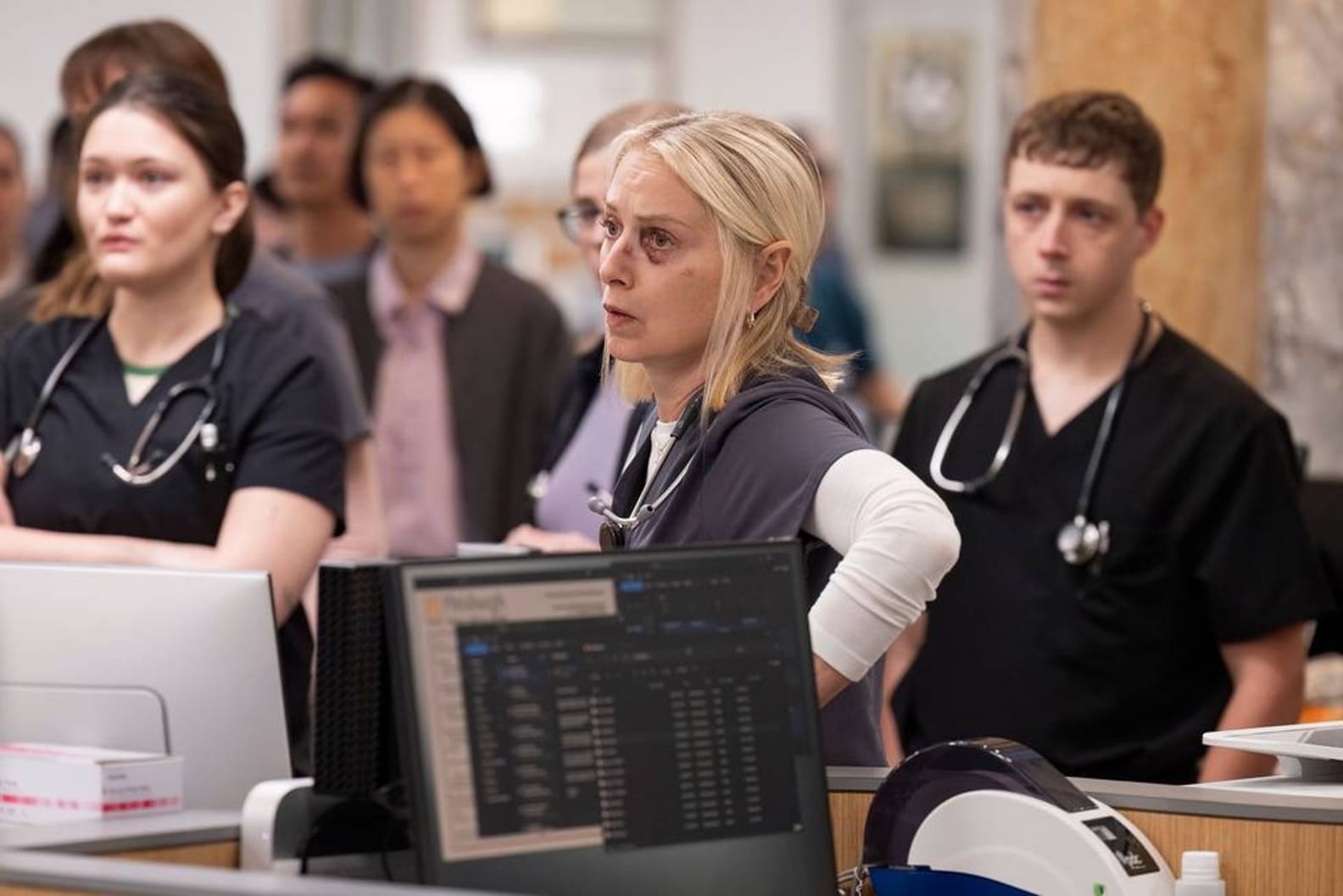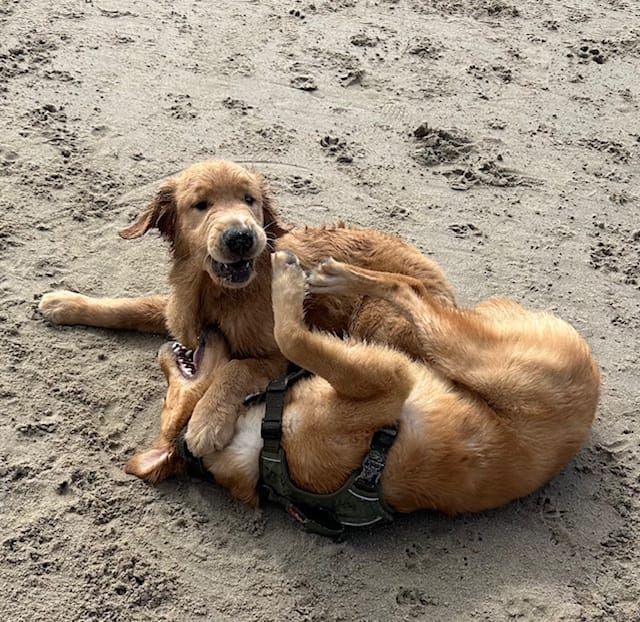Can A TV Show Make Us Better?

"The Pitt" is a spinal tap into some very gnarly stuff. Why is it giving us such... joy?
The sheer watchability of “The Pitt” caught this cynicism-adjacent viewer unaware. Word had gone forth that that Sherri Crichton, who controls certain rights to late husband Michael’s commercial legacy, including the arguably similar longtime TV hit “E.R.”, had characterized the show as a reboot from which she'd been excluded, and was suing corporate parent Warner Bros.
Let’s stipulate that the throwback feel of the show is a great part of its charm. Haven’t many of us wished, especially as our nation’s governance falls prey to morons driving us into a ditch full of toxic seepage, for the chance to go back in time? Not just to fulfill some certain personal time travel bucket list items, like meeting Cleopatra or riding between the spines of an Apatosaurus on the gallop, but staging a life reset on say, November 5, 2024–-when there was still a chance we were all gonna be alright.
It's easy to imagine the world we’d see after a corrected election result. There would be sporadic sightings of Trump golfing, maybe five out of seven days– which is actually still pretty much on his schedule as commander in chief– and meanwhile, Pete Hegseth would be beer-mousse-ing his gunmetal-hued hair in the men’s room of some D.C. bar. There would be some negatives—Elon Musk would be somewhat richer than he now find himself after tanking Tesla’s share price .
( He would probably still be trying to raise the nation’s birth rate if only on his own steam, for proto-nationalist reasons.)
Another big plus from halting time would have been that life in America, and across the globe, would be so much less stupid, and our offspring could live the lives we hoped and believed we had cued up for them.
But as a downside, the MAX channel would not yet have launched the still-blowing-up hit that took us from inauguration week through to now. Across fifteen episodes lasting under an hour each, watching “The Pitt” has in some respects restored an innocence we may have thought was lost for good.
The notion of this medical drama as sustainably sourced pop-cultural pain relief is not novel. As The New Yorker’s Inkoo Kang wrote in February, “The Pitt is exactly where you’d want to be for some counterintuitive comfort TV.” As she adds, “The premise is dead simple: it’s “E.R.” meets “24,” where each episode corresponds to an hour at the hospital. "
As we watch the engaging cast spout medical jabberwocky and deploy zealous, not to say frantic, healing skills as we viewers can swim in the balming ethos of selfless, upright professional behavior. For fifty minutes or so, we can end the slap and snap of bad news and look through our feet at a portrayal of a manifestly good place–-a place where a biblically compassionate man called Dr. Robby shows us what actual caring is all about.
Yes, Dr. Michael Robinavitch, to readers who may have missed the flood tide of warm reviews and fervent friendly recommendations, is the figure who has, in the person of actor (and producer and occasional director) Noah Wyle, taken over the United States of Binge.
As the senior attending physician of a clamorous emergency department at the Pittsburgh Trauma Medical Hospital (ergo the title), we see Dr. Robby, eyes creased with fatigue and caring, mouth often set in an empathetic frown, bosses a small flock of residents, championship-level scrubbed-in surgeons, student doctors, nurses, orderlies, and one overmatched security man. Pouring through the emergency department entrance are successive waves of patients who present as broken, burned, blotto or bummed out enough to demand immediate care. (The less damaged are stuck in a bardo of woe and wrath known as “the chairs”, to be grumblingly entrapped– ostly beyond even the current wait time in real-world Pennsylvania ER’s of three hours.) They sit glumly mute (save for one angry hambone who’s especially hard to watch) while the arrivals vie to be triaged as something exotic enough for the show runners to foreground for we viewers. The scripts uncork urgent medical verbiage even as the ever-willing staff flop the sufferers from gurney to bed for some awesomely unenviable puncturings and tube-threading. While graphic and nerve-wracking, the mending is usually done with the elan and , yes, self-satisfaction, of a magician making very special balloon animals.
Yes, per the contested provenance of Crichton’s complaint, said show runners (R. Scott Gemmill and John Wells) are hardly a surprise pair to be honcho’ing a frankly old-school broadcast style order of 15 episodes. They ran NBC’s era-dominating “E.R.” from 1994 through 2009, and took fledging actor Noah Wyle from a fresh-faced newbie in scrubs to a central role as the earlier show matured. Much like the "E.R." edition , the reliably absorbing Pitt episodes pile up like a crash tutorial in intubation, resuscitation, and instant psychoanalysis, slowed only for occasional dips into a pained but quickly arrested despair of the sort nobody under the big room's bright lights has time to indulge. (You’re not startled when one female doc, in a comradely way, tags a workmate as “a pussy.”)
Visually, the world we’re immersed in is compact, at times claustrophobic. We're mostly stuck on the busy day shift with Dr. Robby once he strolls onto our screens (and in a final bookending sequence, off them). He’s listening to his tunes--a rare needle drop– and the scenes play to the rhythm of their own palaver, all absent a score that might seek to manipulate our mood. Given the general avoidance of typical “the mystery of me” personal chat (with Fiona Dourif’s Cassie McKay a tenderly voluble exception), Wyle is our guide. He acts with his big frame clenched, his face often as remote and saturnine as a Rouault oil of a time-worn king. We've seen him stalk to work as an ambulance wails past, all but oblivious in a “not my job quite yet” way. We’ll learn he carries a dolor dating back to his inability to save his emergency medicine mentor in the terrible days of Covid 19. Present-day social conundrums—of taking “extraordinary measures”, of neurodivergence, of abortion roadblocks and ominous incelhood—come to the fore and test the wisdom and empathy of the staff that barely has time to switch out of their bloodied scrubs.
By the time Dr. Robby has first migrated through his frenetically busy domain…
—and from this point there may come mild SPOILERS—STARTING NOW—
…what he knows as the sirens reach their diminuendo is that Shawn Hatosy’s Dr. Jack Abbott is the night-shift "senior attending," and the hyper-capable military medic turned dark-hours E.R. honcho is always up to the task.
And yet when we meet Abbott he is on the hospital roof, and unnervingly, on the wrong side of the guardrail. Hatosy’s unforgettable visage, the hooded eyes that can convey a ready reserve of inner pain—brought the deep darkness to the lethal-family TV drama “Animal Kingdom."
You probably won’t be second-screening the NBA finals as Abbott rallies the healers to meet the impact of a mass-shooting event at a concert, even as we realize Dr. Robby’s stepson was at that gathering. (PittFest, as it’s unpromisingly dubbed.) The show’s more sensitive stans may ask how the writer’s room could do us like that, but the pain for Robby only escalates for two episodes further, then and impels him and us into a sequence that will surely be much cited when the Emmy voting commences. A hallmark of the show's’ wise choices is the way we see Welsh actor (and RADA grad) Gerran Howell’s farm-raised student doctor Whitaker, whose wide-eyed mien signals “mere youth,” talk his boss and us all off the ledge with studiously casual japes. (The show keeps its few guttural laughs stashed for moments like these.)
We expect no less than humble heroism from Wyle’s central character from the moment he first migrates through the ever-shifting near-madness of the ER, which set was built on a soundstage on the Warners lot. It's located next to where NBC's “E.R.” was shot—so the camera work, always logical rather than ostentatious, can wheel in a circle to embrace convincing tidbits of background action. (Indispensable crew members donned scrubs as camouflage when they might be caught in a shot.)
One of the winning achievements of the show is that it so nimbly presents a rotating cast of characters, and so compactly gives us inside glimpses of their psyches with minimal expository chats, that nearly every one of the practical and emotional story beats rewards our attentiveness. Early on, we’ve met Dana Evans (Katherine LaNasa), the charge nurse. Deeply humane, she’s as capable as anyone on the floor, but instead of spreaders and scalpels, wields gruff wit, fierce organizational gifts, and a top sergeant’s command skills.

The vintage prototypes for TV doctors include “Ben Casey,” which ran from 1961 to 1966 on ABC. Star Vince Edwards described Casey as "a no-nonsense, rough-hewn doctor with no bedside manner whatsoever." By contrast, NBC’s “Dr. Kildare” competed by starring Richard Chamberlain (who died just last month) as kindlier. As an exhausted intern in "Dr. Kildare"'s inaugural episode. “Twenty-four Hours,” he quieted an abusive alcoholic dame with tales of fishing in her home town. (Broadcast TV diverted us from the news then, too, even while then, as now, the White House was targeting Communists.)
If “The Pitt” has a pin-up, it’s Patrick Ball as resident Dr. Frank Langdon, a budding savior type whom Dr. Robby has clocked as a star in the making. It’s not Ball’s fault that he fits the description of Zooey Glass, the TV star J.D. Salinger sketched in “Franny and Zooey” as “surpassingly handsome, even spectacularly so,” looking like "the blue-eyed Jewish-Irish Mohican scout who died in your arms at the roulette table at Monte Carlo." About to star in an adaptation of “Hamlet” at the Mark Taper forum in Los Angeles, Ball said in a recent interview he wasn’t sure if he’d be back for the second season—but his character does have a way of turning up unexpectedly.
If he does, he’ll have to face off with Langdon’s fictive nemesis–-owing to a plot point best left to its own unveiling)–-the contrary, ego-ridden intern, Dr. Trinity Santos. Half-Filipino herself, actress Isa Briones won some added scripted moments in which she trades lines in Tagalog with the gossipy, side-eyeing nurses Princess and Perla. The trio's half-buried sardonicism barely undercuts their down-by-ER-law zealousness at crunch time. (And it’s almost always crunch time.) Santos seemingly oversteps her mandate with a near-magic, ad lib chest tube insertion, which Abbott sternly scolds her for before whispering, “That was pretty badass.”
There’s too much to say in this space about too many more highlights, but if there's some shippable romance brewing, it may involve as meme-able audience favorite Taylor Dearden as Dr. Melissa “Mel” King, the self-driven ombudswoman to the weary and burdened patients.
After a season of meh-watching “The White Lotus” and failing to care a whit about the entire troupe (though Walton Goggins found his own virtuous craft box), and after having my face rubbed into what I didn’t know about the actual, original plot of “The Last of Us,” I remain grateful, after switching off the reports of greedy, soulless amateurs dismantling our democracy, to have such a compelling blast of real life shown by the mostly selfless folk Wyle et al. have tossed on our plate. They’re showing a decency more of us might emulate. “Welcome to the Pitt,” Dr. Robby says early on to the interns, and to our admiration, "Now let’s save some lives.”


Comments ()